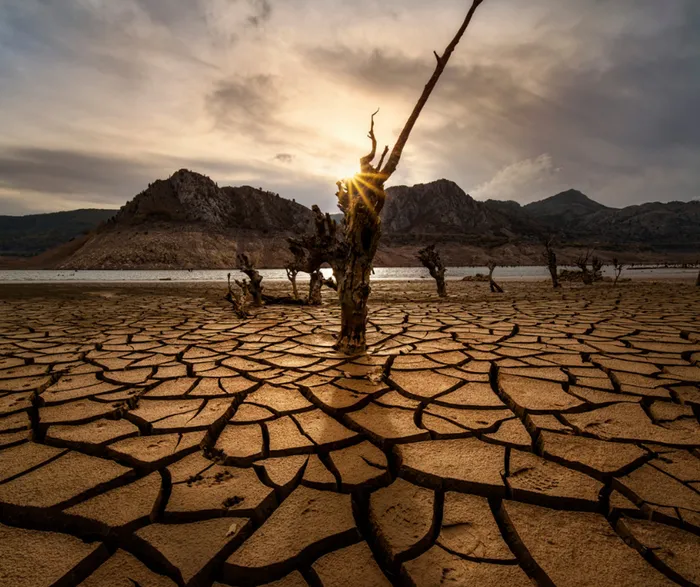Drought, extreme heat on the cards for South Africa, the Continent

Picture: ANA File – The World Health Organisation warned in December last year that extreme climate-driven weather disasters across a dozen African countries are threatening the physical and mental development of an entire generation with the situation unlikely to improve in 2023.
By Dominic Naidu
According to the latest reports from climate experts on the Continent and around the world, Africa and South Africa are likely to experience increased heat waves, droughts, floods and other related extreme weather events in 2023.
The World Health Organisation warned in December last year that extreme climate-driven weather disasters across a dozen African countries are threatening the physical and mental development of an entire generation with the situation unlikely to improve in 2023.
The worst drought in at least forty years continues to sweep across the Horn of Africa with floods and water shortages affecting West Africa’s Sahel region leaving 76 million people facing dire food insecurity. Parts of Somalia are already on the verge of famine.
“These disasters, exacerbated by conflict and civil war, are driving malnutrition among infants and causing disease outbreaks as people migrate in search of water and food, and overrun health systems struggle to respond,” said Anil Soni, the WHO Foundation’s chief executive officer.
The combination of hunger and conflict are “going to affect children’s physical and mental development for generations to come,” Soni said in an interview in December. “Whether or not we lose millions of lives or less, I think depends on how quickly we act.”
Across the Sahel and Horn of Africa regions, 15 million people have been internally displaced by weather disasters and conflict. Nigeria, Burkina Faso, Ethiopia, Somalia, Sudan and South Sudan are among the worst-affected nations.
In the Horn of Africa, significant rains have failed to arrive for five consecutive seasons, with the last season having been the driest in 70 years. Bizarrely, just across the border, 40 percent of the landmass in South Sudan lay underwater toward the end of last year, the third consecutive year this has happened.
“There’s no reason to believe that the weather in 2023 is going to be any better than the weather this year,” Soni said. “What you’re seeing is year-on-year things getting worse.”
Johan van den Berg, independent agricultural meteorologist consulting for Grain SA said in October last year that most of South Africa received average to above-average rainfall since 2020 which has resulted in flooding or water-logged conditions in some regions damaging crops and infrastructure.
These higher than usual wet conditions since 2020 were a steep contrast to the severe drought conditions over large parts of the country from 2014 to 2019.
Explaining the possible reasons behind South Africa’s recent highly volatile climate, van den Berg said that “the most important factor responsible for these fluctuations is the El Niño Southern Oscillation (ENSO), which has two main components, El Niño and La Niña”.
Nasa scientists predict that the relentless increase in global temperatures will continue this year, bringing even more disruptive weather that is the signature calling card of accelerating climate breakdown.
New Scientist reported that, according to the UK’s Meteorological Office, "a global shift to an El Niño climate pattern later this year could pave the way for the world to breach +1.5°C of warming for the first time in 2024."
“It makes farming in South Africa very difficult – ranging between the extremes of severe drought or very wet conditions for consecutive seasons,” explained van den Berg.
“Although this happens thousands of kilometres from South Africa, is it responsible for shifts in rainfall patterns not only over South Africa but over the world.”
In South Africa, an El Niño event results in drier than normal conditions and wetter than normal conditions with a La Niña present.
Niña conditions started to develop in the spring of 2020, causing favourable rainfall conditions initially over the eastern and central parts of the country but gradually spreading to the western parts.
Although La Niña is favourable for rainfall over the summer rainfall area of South Africa, the impact is not always the same across the country, for instance in the Eastern Cape, where poor rainfall conditions are still causing severe drought after more than two years of La Niña conditions.
Although La Niña conditions are still present, it is expected that it will last until at least the first half of this year which will only be the third time since 1950 that there will be three consecutive La Niña events, because La Niña events usually last a single season, from around September to April.
“Mpumalanga, Gauteng, Eastern Free State and northern parts of KwaZulu-Natal are expected to receive above-average rainfall well into February,” said van den Berg.
Drier conditions are possible from about February 2023, with the forecast of the current La Niña that will weaken from early 2023.
With the expected weakening of La Niña, there is a high probability for drier conditions from about the second part of February 2023.
Below-average rainfall is highly possible for the winter rainfall region, eastern parts of the country, from about April 2023, indicating the start of a new dry cycle.
Although global warming is evident, there are also impacts on rainfall and it can even be responsible for lower temperatures in some areas for specific times of the year.
The turning point of the current wet cycle towards a drier period will most probably begin to develop from about 2023 in the central to western summer rainfall area of South Africa.
Dominic Naidoo is Environment Activist and writer.
This article is exclusive to The African. To republish, see terms and conditions.